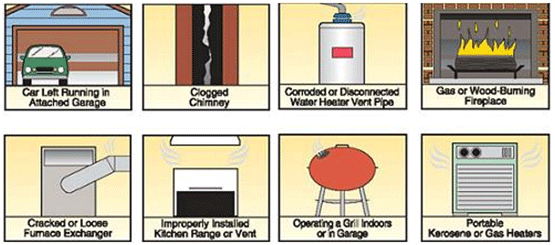What is the "Silent Killer"?
Carbon Monoxide (CO) also known as the “Silent Killer,” is invisible, odorless and colorless. According to the Center for Disease Control (CDC), CO is the leading cause of accidental poisoning deaths in America with over 430 deaths and 50,000 emergency department visits annually.
- A person can be poisoned from CO over a long period of time or over a shorter period of time by an excessive amount of exposure to CO.
- Despite many state and local laws, only 27% of homes in America have CO alarms, according to the Hardware/Homecenter Research Industry.
- CO poisoning deaths from portable generators have doubled for the past two years, and many of these deaths occurred in the winter months and during power outages.
- The dangers of CO exposure depend on a variety of instances, including the victims overall health and activity level. Infants, pregnant women and people with physical conditions that limit their body’s ability to use oxygen can be more severely affected by lower concentrations of CO than healthy adults would be.
Symptoms of CO
According to the CDC, red blood cells pick up CO quicker than they pick up oxygen. If there is a lot of exposure to CO, the body may replace oxygen in the blood with carbon monoxide, which blocks oxygen from getting into the body and can damage tissue and result in death. Symptoms associated with CO poisoning include:
- Most Common:
- Headache, dizziness, weakness, nausea, vomiting, chest pain
- High levels of CO inhalation can cause:
- Loss of consciousness
- Death
CO poisoning can be difficult to diagnose because the symptoms mimic other illnesses such as the flu. People who are sleeping or are intoxicated can die from CO poisoning before ever experiencing symptoms.
CO combines with hemoglobin, the oxygen-carrying agent in the red blood cells. When oxygen is robbed from the brain and other organs, death can result. In addition, up to 40 percent of survivors of severe CO poisoning develop memory impairment and other serious illnesses.
Many cases of reported carbon monoxide poisoning indicate that victims are aware they are not well but become so disoriented that they are unable to save themselves.
Where CO is Found
According to the CDC, CO is usually found in combustion fumes, such as those produced by cars and trucks, small gasoline engines, stoves, lanterns, burning charcoal and wood, gas ranges and heating systems. From these sources CO can build up in enclosed or semi-enclosed spaces, such as a closed garage door or various areas in the home.

Preventative Steps
- Install at least one UL-Listed battery-powered CO alarm or AC-powered unit with battery backup on each level of your home and near sleeping areas.
- CO alarms do not last forever. Replace CO alarms every five to 10 years (depending on manufacturer). Check the manufacture date on the back of the alarm, as well as the owner’s guide for replacement recommendations.
- Test CO alarms at least once a month.
- If the CO alarm sounds, immediately move to a fresh air location outdoors or by an open window or door. Make sure everyone inside the home is accounted for. Call for help from a fresh air location and stay there until emergency personnel arrive.
- Do not block or shut the exhaust flues or ducts used by water heaters, ranges and clothes dryers.
- Do not use charcoal or gas grills inside or operate outdoors near a window where CO fumes could seep in through a window.
- Do not leave your car running in an attached garage or carport.
- Do not use ovens or stoves to heat your home.
- Make sure appliances are installed and operated according to manufacturer's instructions.
- Have the heating system, chimney and vents inspected and serviced annually.
- Examine vents and chimneys regularly for improper connections, cracks, rust or stains.
- Make sure to read your CO alarm's user's guide and keep it near your CO alarm for quick reference.
Proper Alarm Placement
It is important to install a carbon monoxide (CO) alarm in the right location. If only one CO alarm is being installed, the Consumer Product Safety Commission (CPSC) recommends it be located near the sleeping area, where it can wake someone sleeping. Additional alarms on every level and in every bedroom of a home provides extra protection against CO poisoning.
Homeowners should remember not to install CO alarms close to fuel-burning appliances. They may emit a small amount of CO upon start-up and activate the alarm. An alarm should not be placed within 15 feet of heating or cooking appliances or in or near very humid areas such as bathrooms.
Installation locations vary by manufacturer so make sure to read the provided installation manual for each alarm before installing. The IAFC recommends a CO alarm on every floor of your home, including the basement. An alarm should be located within 10 feet of each bedroom door and there should be one near or over any attached garage.
It is important to note that CO alarms do not serve as smoke alarms and vice versa. However, dual smoke/CO alarms are readily available. Smoke alarms detect the smoke generated by flaming or smoldering fires, whereas CO alarms can alarm people about dangerous levels of CO and help prevent CO poisoning.
Since CO is colorless, tasteless and odorless, detection and prevention of CO poisoning in a home environment is impossible without such a warning device.
Although all CO arms use an audible alarm signal as the primary indicator, some versions also offer a digital readout of the CO concentration, in parts per million. Typically, they can display both the current reading and a peak reading from memory of the highest level measured over a period of time.